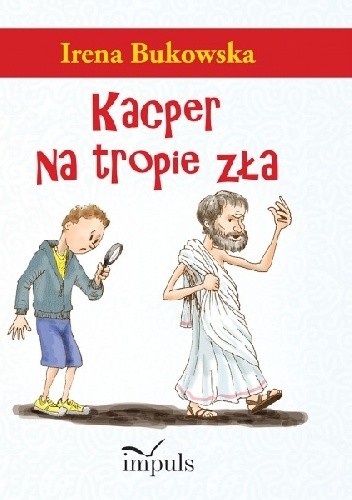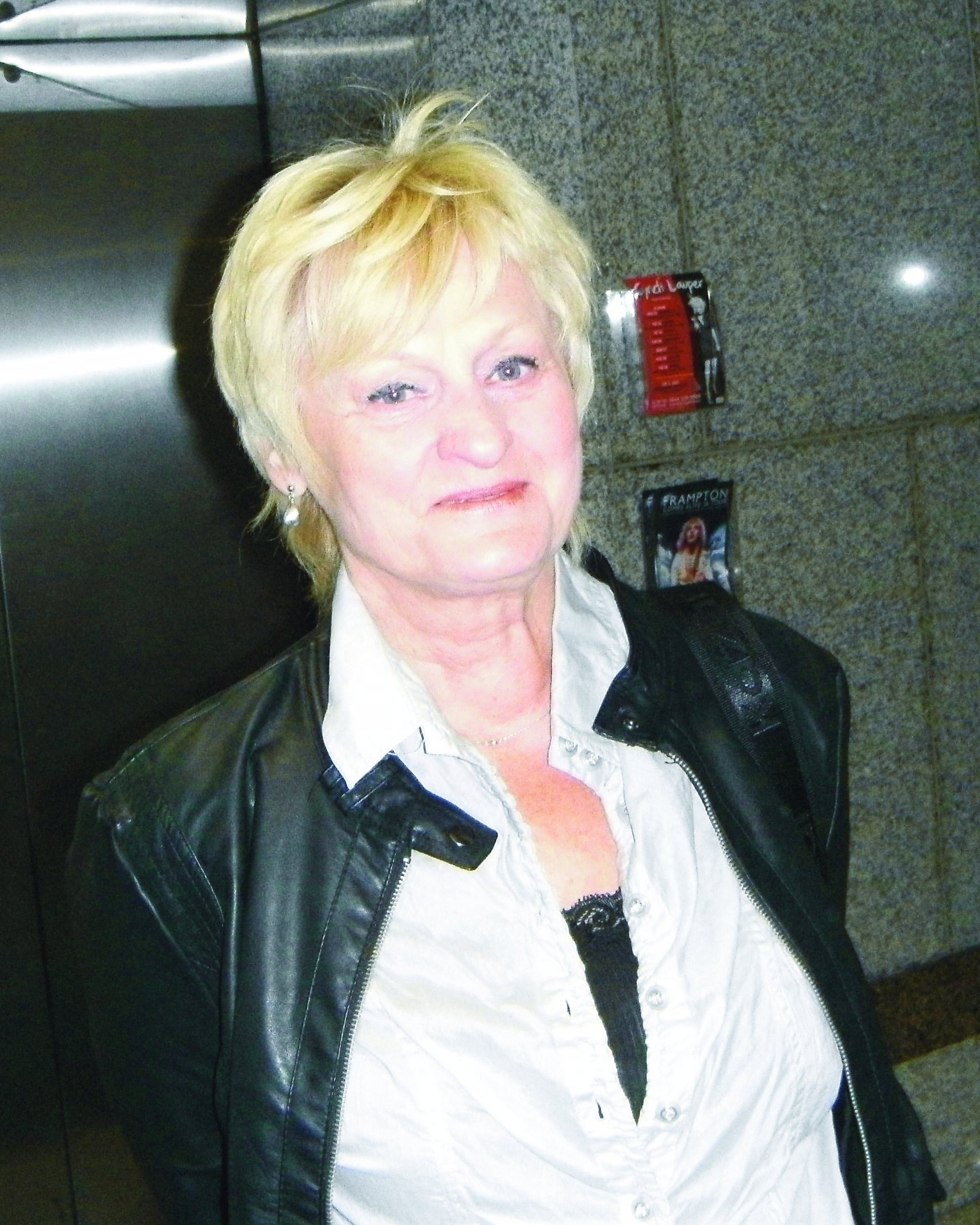Title of the work
Country of the First Edition
Country/countries of popularity
Original Language
First Edition Date
First Edition Details
Irena Bukowska, Kacper na tropie zła, ill. Piotr Olszówka. Kraków: Impuls, 2016, 264 pp.
ISBN
Genre
Novels
Time-travel fiction
Target Audience
Children (12+)
Cover

Courtesy of the publisher.
Author of the Entry:
Marta Pszczolińska, University of Warsaw, m.pszczolinska@al.uw.edu.pl
Peer-reviewer of the Entry:
Elżbieta Olechowska, University of Warsaw, elzbieta.olechowska@gmail.com
Daniel A. Nkemleke, University of Yaoundé 1, nkemlekedan@yahoo.com
Photograph courtesy of the Author.
Irena Bukowska
, b. 1942
(Author)
A philosopher, Doctor of Arts, in retirement since 2006 (she is still a lecturer of philosophy at private colleges). She worked at the Medical University of Gdańsk (1977–2006) and the Gdańsk Academy of Fine Arts (1999–2006). She lectured on history of philosophy, ethics, pedagogy, and theory of culture. As a pedagogue, Irena Bukowska developed an educational method for teaching philosophy at secondary school. Member of Polskie Towarzystwo Filozoficzne [Polish Philosophical Society], she is engaged in organising Polish Philosophy Olympics and in preparing high school students for that competition. She is very successful in that field – she received a prize from the Committee for Polish Philosophy Olympics and a medal from the Commission of National Education. She also received an award from Poznański Przegląd Nowości Wydawniczych “Książka Wiosny ‘97” [Poznań Review of New Publications “Book of the Spring ‘97”] for the novel Kacper w krainie filozofów [Kacper in the Land of Philosophers], 1997.
Bio prepared by Anna Ślezińska, University of Warsaw, annie_s@o2.pl
Sequels, Prequels and Spin-offs
Irena Bukowska, Kacper w krainie filozofów, Poznań: W drodze, 1997.
Summary
Kacper from Gdańsk, known to the reader from Kacper w krainie filozofów, is already a teenager. He is a mediocre student, but a curious one – he likes asking questions and considering even ordinary things as he has a soul of a philosopher and a poet. An emaciated, mistreated and abandoned dog rescued by the narrator makes him reflect and ask questions about the essence of evil.
Having left for a sailing camp, Kacper and his friend Piotrek get on board of a ghost ship balancing between light and darkness. They are pulled into the dark where they are overwhelmed by negative emotions: anger, aggression, an urge to tease and swear, and experience a presence of dangerous creatures. Then they become victims of an explosion which launches them into space, to the zodiac wheel. Their rage goes away and the boys land on the ground embarrassed by the evil they have discovered within themselves. On earth, they meet many famous philosophers trying to explain the nature of evil.
First of all, they talk to Mani who explains the situation they experienced on the ghost ship. The two next philosophers they meet, Saint Augustine of Hippo and Thomas Aquinas, explain what evil means for them. They jump 800 years further into the past, Piotrek is healed from an illness at a cloister, where newcomers/guests debate on the topic of pleasure as seen by Aristippus, Diogenes and Zeno. One of them, Armando, takes the boys with him to Paris in order to do his assignments at the university. Kacper gets a copy of Aristotle’s Metaphysics to study and make marginal glosses and notes instead of Armando, who amuses himself in Paris. A lecture at the university reveals differences between Thomas and Aristotle. Kacper also meets René Descartes, attends a lecture by Julien de la Mettrie, observes an autopsy performed in the city square, which he compares to a visit in an ancient theatre, and then he witnesses an execution of a witch. Due to his sympathy for the victim of a false accusation, he tries to protect her and is arrested. While still in Paris, he meets J. J. Rousseau, who considers society and civilization the source of evil, and Leibniz, for whom evil is rather a consequence of imperfection of man – God created the best possible world, in which evil is the least good.
Kacper travels to Padua accompanied by a stranger. In Padua he once more meets the philosophers mentioned before (Socrates, Plato, Aristotle, Augustine of Hippo, Thomas Acquinas) where they do not allow to use the name “academy” for a shady for-profit institution that degrades learning out of greed. Then the boys meet Thomas Hobbes and his Leviathan, Albert Schweitzer, full of compassion, and Arthur Schopenhauer. Finally, the protagonists return to the sailing camp. Kacper still does not know where evil comes from and why a man is good or evil, but he wants to act in a way that does not bring harm to himself and others. Having returned from his holidays, he helps the owner to care for the adopted dog which contributes to making the world better.
Analysis
The book is a short course of philosophy focused on the topic of evil, targeted at adolescents. The narrative device – meeting and discussions of the topic with eminent philosophers as part of Kacper’s adventure – allows the author to introduce historical figures and their views about evil and its origin in a manner more interesting than a straight lecture.
The harm made by humans to an innocent animal become a pretext to introduce philosophical discussions and positions. In addition to the adopted dog, another suffering animal is presented to the reader at the end – a horse dying of exhaustion, mistreated by the owner, but on the other hand, protected by Albert Schweitzer from being beaten.
References to classic antiquity are introduced metaphorically, presenting philosophical constructs, which sometimes become tangible in the descriptions of events experienced by the protagonists (e.g. they can climb Aristotle’s pyramid or see it collapse).
First, the meeting with Mani reveals the Manichaean myth of creation and conception of a human being in whom two opposite powers constantly fight. Mani indicates gnosis as the way to defeat the evil inside.
The scene set in ancient Hippo in the times of the bishop Augustine reveals the most references to antiquity. The place is at first recognized by the boys as the Roman Forum, based on clothing, rostra and statues, but it proves to be a forum in Roman Africa. They explore a local market seen as a place of trade and entertainment, and go to a church where they are surprised by the ancient décor, customs and organization there, quite different from what they know. The sermon reveals Saint Augustine’s point of view that evil comes from man and is understood as a lack of good.
Meeting with Thomas Aquinas is an opportunity to present philosophical views, the author also uses metaphorical images. In a desert, the boys reach a gate of a strange farming estate, where plants grow in silence, as there are no animals. Beyond the second gate they discover a richer, perfect world full of animals. The next gate leads to a mountain-pyramid, which later appears to have been created by Aristotle. On the top of the pyramid, they expect to meet a human – it is Thomas Aquinas who waits for them before they enter the next stage. The top is hidden behind a curtain – they are guessing that it covers something of utmost perfection. Aquinas explains that, according to Aristotle, a pure form is hidden there, but he believes that it is God. The evil is absent in the pyramid as it does not have a form: it was not created by God. It can be regarded as a lack of perfection. The image of the metaphorical pyramid appears once more when Kacper, accompanied by René Descartes, sees it collapse which symbolises, that form is not necessary for the material world to exist.
Ancient philosophers are also featured not as specific characters. In the discussion at the monastery and during the university lecture in Paris, the views of the ancients regarding different matters are presented and thus the young protagonists can learn about them in many ways. The trip to Padua is an occasion to present Plato’s views as Kacper’s companion tells a metaphorical story revealing Plato’s statement about the human soul and his model of a state. He uses imagery of the chariot of Reason pulled by Spirit and Appetite. To achieve a goal they have to become a unity, despite the fact that Reason is often too weak to influence Will and Desires. If a human soul stares at light, the man becomes good; if the soul looks down, it knows no good and does no do good. The last scene when the ancient philosophers appear is set in a suspiciously modern academy, completely different from the Academy and its values – they come to protest unauthorized use of the name “academy”. As the seekers of truth, they deny that philosophy is useless and forbid disparaging the achievements of men.
In the end, the author places the list of all philosophers mentioned with some characteristics of their views, also providing additional information about the Academy. A considerable asset of the book is a bibliography containing both elaborate studies and ancient sources, such as Diogenes Laertius and Plato.
Further Reading
Diogenes Laertius, Lives of Eminent Philosophers, R. D. Hicks, ed., Cambridge, Mass.: Harvard University Press, 1972 (ed. pr. 1925); English translation (accessed: July 5, 2021); Greek Original (accessed: July 5, 2021).
Diogenes Laertios, Żywoty i poglądy słynnych filozofów, trans. Irena Krońska, Kazimierz Leśniak, Witold Olszewski, Warszawa: Państwowe Wydawnictwo Naukowe, 1992.
Legowicz, Jan, Historia filozofii starożytnej Grecji i Rzymu, Warszawa: PWN, 1973.
Plato, Platonis Opera, John Burnet, ed., Oxford: Oxford University Press, 1903.
Plato, Plato in Twelve Volumes, Vol. 9, trans. Harold N. Fowler, Cambridge, Mass.: Harvard University Press and London: William Heinemann, 1925.
Platon, Państwo, trans. Władysław Witwicki, vol. 1–2, Warszawa: PWN, 1958.
Schweitzer, Albert, Aus meiner Kindheit und Jugendzeit, München: C. H. Beck, 1985.
Schweitzer, Albert, Moje życie, trans. Krystyna Krzemieniowa, Lublin: Daimonion Instytut Wydawniczy, 1991.
Tatarkiewicz, Władysław, Historia filozofii, vol. 1–2, Warszawa: PWN, 1978.



